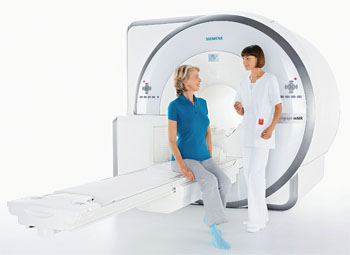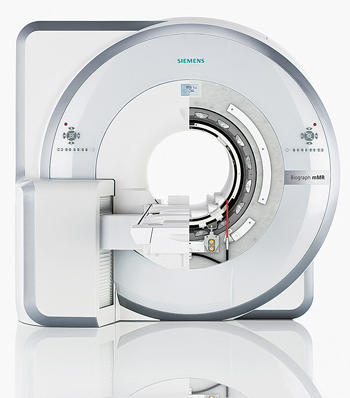
Until now, it was nearly impossible to integrate MR and PET technologies. The conventional PET detectors that use photomultiplier tubes could not be used in the strong magnetic field generated by an MR system. Integration was further limited by the lack of space inside the MR device. For this reason, MR-PET imaging was the result of two separate scans (MR and PET) with a significant time lag. With Biograph mMR, Siemens Healthcare brings the first molecular MR system for clinical research that integrates MR with compact, specialised PET detectors. The Biograph mMR incorporating TIM, the "Total Imaging Matrix" technology from Siemens, may make it even quicker and easier for clinicians to perform the MR examination.
The Biograph mMR is the world's first integrated whole-body molecular MR with simultaneous data acquisition technology, which is currently undergoing clinical use testing. This revolutionary system comprises a MR scanner and an integrated PET detection system with an architecture that performs as one. In the new 3-tesla hybrid system, Siemens developers have succeeded for the first time in simultaneously capturing MR and PET data with a whole-body system. The Biograph mMR system has been installed at the university hospital Klinikum rechts der Isar of the Munich Technical University, Germany.
Prof. Dr. Markus Schwaiger, director of the clinic for nuclear medicine at the university hospital, said, "Together with our partner Siemens, we are entering a new dimension in diagnostic imaging today. We have initiated clinical use testing of Biograph mMR in an effort to diagnose diseases at a very early stage, to see the progression of disease, and to use that information to develop a therapy plan precisely focused on the respective patient. Furthermore, we plan to use the system for cancer follow-up in the long run by reducing radiation exposure by the use of the system."

With the simultaneous acquisition of MR and PET data, Biograph mMR is designed to provide new opportunities for imaging. While MR provides exquisite morphological and functional details in human tissue, PET goes further to investigate the human body at the level of cellular activity and metabolism. The innovative system has the potential to be a particularly valuable tool for identifying neurological, oncological, and cardiac conditions of disease and supporting the planning of appropriate therapies. Since MRI does not emit ionising radiation, Biograph mMR may provide an added benefit with lower-dose imaging. The Biograph mMR also opens new opportunities for research, such as the development of new biomarkers or new therapeutic approaches.
"Biograph mMR is the latest breakthrough innovation of Siemens in the field of diagnostic imaging. It will be a new instrument for driving personalised medicine forward," said Walter Maerzendorfer, CEO of the Business Unit Magnetic Resonance at Siemens Healthcare. "Biograph mMR is designed to simultaneously acquire morphology, function, and metabolism for the entire body," added Britta Fuenfstueck, CEO of the Business Unit Molecular Imaging at Siemens Healthcare.
MR and PET have become an established part of everyday healthcare routines and have been proven to be valuable clinical diagnostic tools. The integration of these two technologies into a single system capable of simultaneous acquisition brings the potential to revolutionise the diagnosis of many conditions. Initial research suggests that, with this system, molecular MR can scan the entire body in as little as 30 minutes for the combined exams compared to 1 hour or more for sequential MR and PET examinations.Chuck Taylor All Star

 iConnectHub
iConnectHub
 Login/Register
Login/Register Supplier Login
Supplier Login


























